How To Apply Intense Effect Powerpoint 2016
This step-by-step PowerPoint timeline tutorial will show you how to make professional timelines right inside the popular presentation tool.

Microsoft PowerPoint enables users to create a basic timeline that they can manually adjust and restyle to fit their needs. The result is a simple graphic fit for presentations to clients or executives, but not quite flexible enough for those who need to show more accurate details or update the timeline regularly.
If you need to regularly create and update timeline slides for high-level presentations, a simple and fast solution would be to use a timeline maker for PowerPoint that automates the process. On this page, you will see both the manual and the automatic way to make a timeline in PowerPoint.
Which tutorial would you like to see?
How to manually make a timeline in PowerPoint
1. Create a basic timeline graphic.
If you prefer to manually build a PowerPoint timeline, you will need to use PowerPoint's SmartArt tools to create a basic visual and then adjust that graphic to make it look better fit for presentations. Here are the exact steps:
-
Create a new presentation or open an existing one and add a new blank slide.
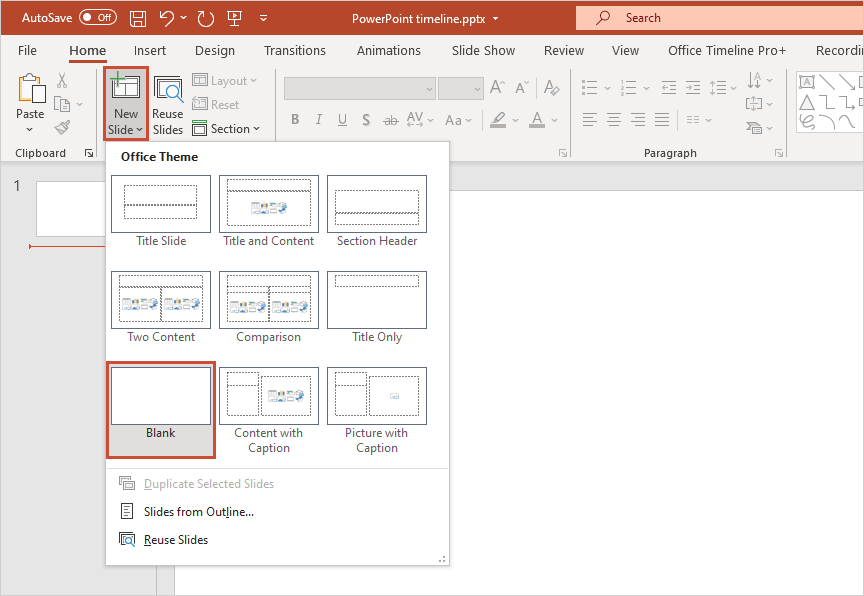
-
Go to the Insert tab on the PowerPoint ribbon and click on the SmartArt button in the Illustrations section.

-
In the window that pops up, select the Process category, where you will find a variety of graphic options to choose from for your PowerPoint timeline. For a simple graphic that clearly shows the key events or milestones of a project, we'd recommend choosing the Basic Timeline.
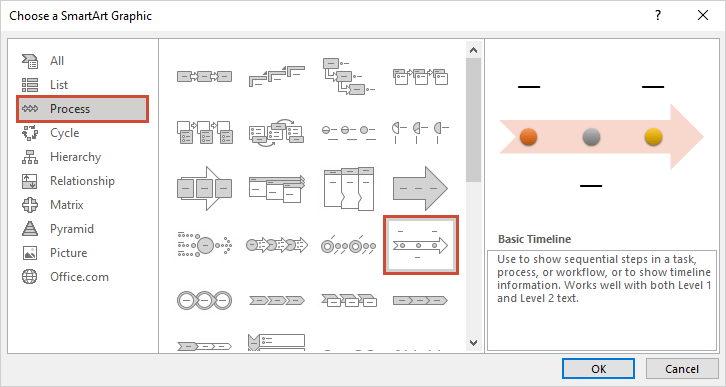
You can change the style at any time from the SmartArt Tools Design tab on the ribbon if you want to try out different layouts for your graphic.
2. Add your data.
The default graphic generated by PowerPoint will have placeholder text and only 3 milestones. You can insert your own data directly on the graphic by typing inside the [Text] boxes on the slide, but adding new milestones or events besides the 3 default ones can become a little tricky this way. That's why we'd recommend using the Text Pane instead, as it's faster and it allows you to easily add extra milestones to your PowerPoint timeline. Here's how it works:
-
If the Text Pane is not already visible, click on the small icon right on the left of your timeline arrow to open it.
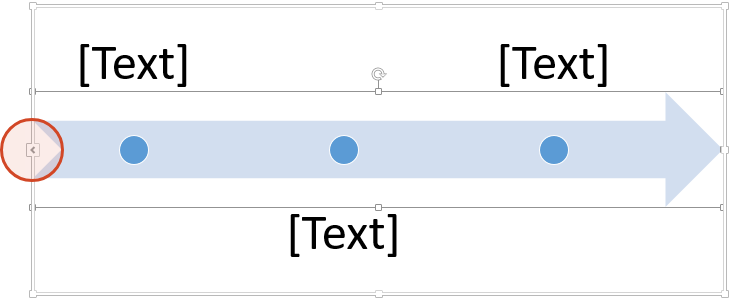
-
Here, type in your milestone dates and descriptions, and PowerPoint will automatically update the graphic. Press Shift + Enter to insert a line break and show the date and description of a milestone one below the other.
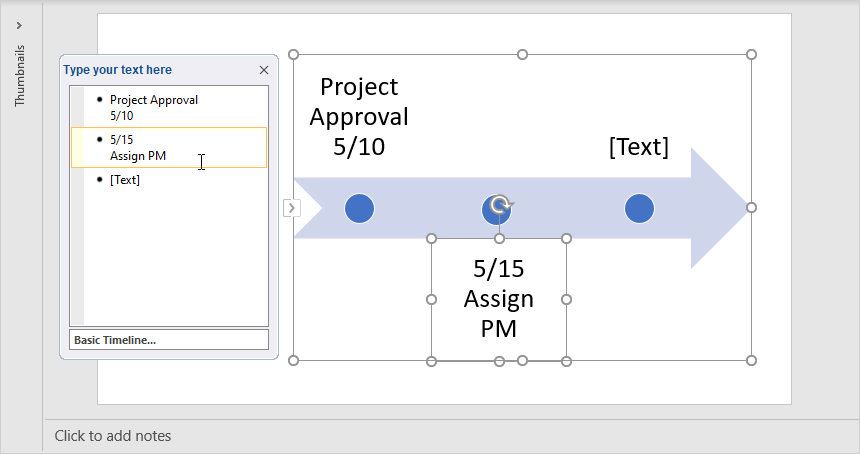
Note: You'll notice that PowerPoint places your milestones equidistant on the timeline, regardless of the relative distance between their dates. This is because the tool "reads" the dates you enter as plain text, so it can't calculate the number of days between two milestones. You can manually drag milestones closer to or farther away from each other, but as you add more items on the timeline, the layout will get distorted. That's why we'd recommend leaving them as they are.
-
To add more milestones to your PowerPoint timeline, simply press Enter after an existing item in the Text Pane and insert your data. You'll notice that PowerPoint automatically shrinks the text size the more events you add to your timeline. To ensure your data remains easy to read, it would be safe to keep a maximum of 5 to 7 milestones.
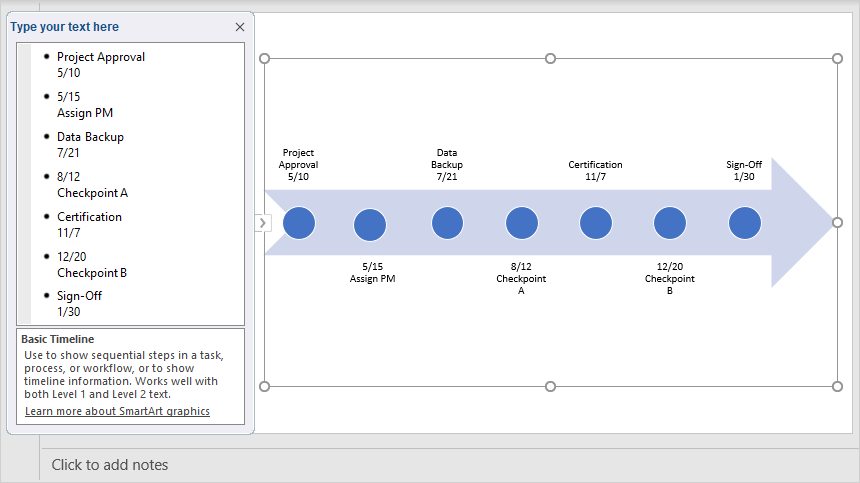
When building your PowerPoint timeline, you may be tempted to manually increase the size of the text for improved legibility. We would suggest avoiding that because it tends to ruin the whole layout. Instead, you can expand the size of the graphic box as we did above, and PowerPoint will automatically make the milestone descriptions larger too.
3. Customize your timeline.
Now you can apply some styling choices if you want to make your PowerPoint timeline look more unique.
-
To customize the overall look of your timeline, you can change the SmartArt Styles and color palettes from the SmartArt Design tab on the ribbon. In our example, we chose a darker color scheme from the Change Colors dropdown and selected the Intense Effect option from the Styles menu to make the milestone circles stand out a bit better.
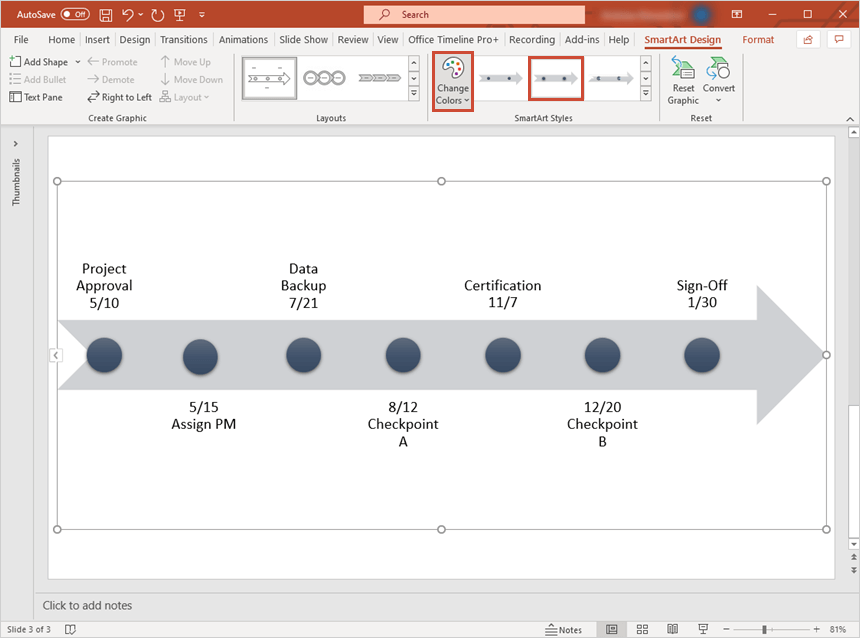
-
While the SmartArt functions apply to the whole graphic, you can also customize individual items to make a more unique PowerPoint timeline. To do this quickly, right-click on any item and use the formatting options that pop up to restyle it. For instance, you can use Shape Fill to make specific milestones stand out or change the dates' Font Color to differentiate them better from the milestone descriptions.
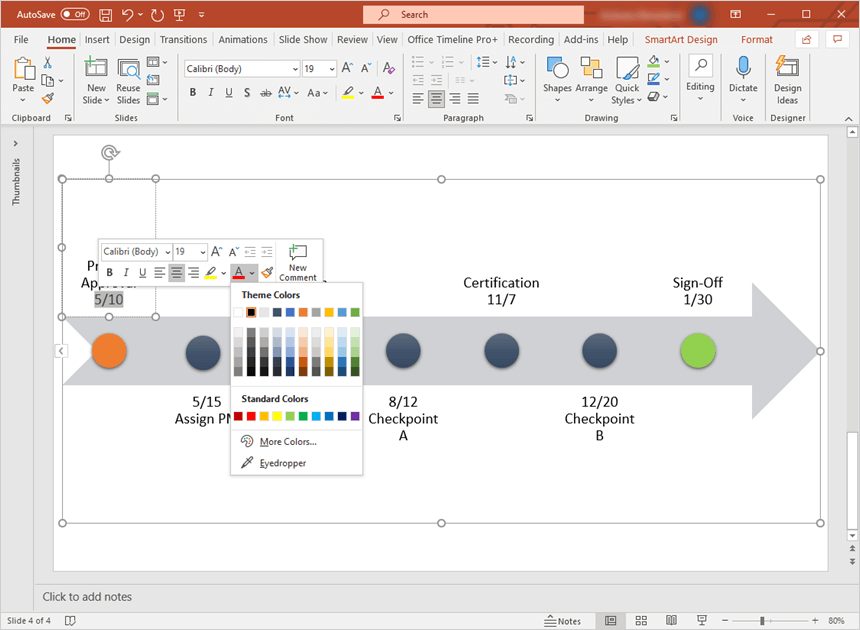
-
Now, to make the milestones easier to follow, you can use drag & drop to slightly narrow the arrow shape and move the circles closer to their corresponding descriptions. It may take a while to find the ideal positioning, but it will help guide your audience's eye when looking at your timeline in PowerPoint.
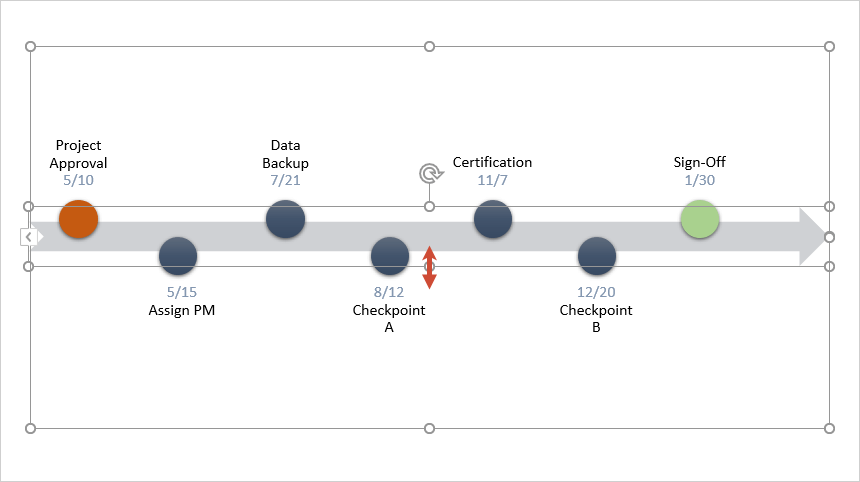
-
Finally, you can also play with the milestones' sizes and shapes to get a more unique visual or draw attention to key data. To do so, select the objects you wish to customize and, using the options in the Format tab, you can resize them quickly or switch to other shapes.

After testing more shapes and sizes using the Format tab, our timeline now looks like this:

That's it – these were the steps to manually making a timeline in PowerPoint. If you'd like to use the timeline created in this guide as a template to help you move faster, you can download the slide below, free of charge.
Download manual timeline slide
How to make a timeline in PowerPoint automatically
Manually creating and managing a timeline in PowerPoint is not only time-consuming but can also get quite frustrating if you want to make custom changes or updates to the visual.
In the steps below, we will show you how to quickly build, customize and update your graphic using Office Timeline, a lightweight PowerPoint timeline maker add-in that automates the whole process. To begin, you will need to install Office Timeline, which will add a new tab to the PowerPoint ribbon.
1. Open PowerPoint and insert your data into the Office Timeline wizard.
-
Inside PowerPoint, go to the Office Timeline tab, and then click on the New icon.

This will open a gallery that provides a variety of styles and templates you can choose from for making a timeline in PowerPoint.
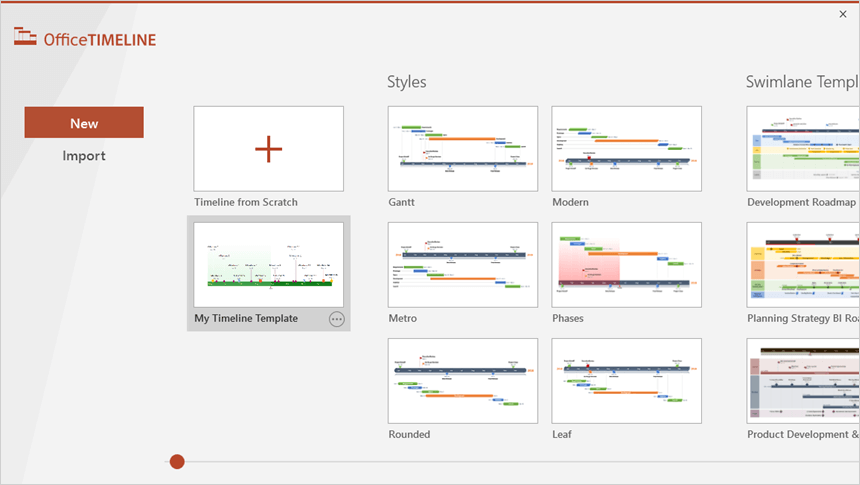
-
To select your preferred template or style from the gallery, double-click it and then click Use Template in the preview window to open the Data Entry Wizard. In this example, we will be using a custom PowerPoint timeline template we made earlier, which is available for download at the end of this tutorial.
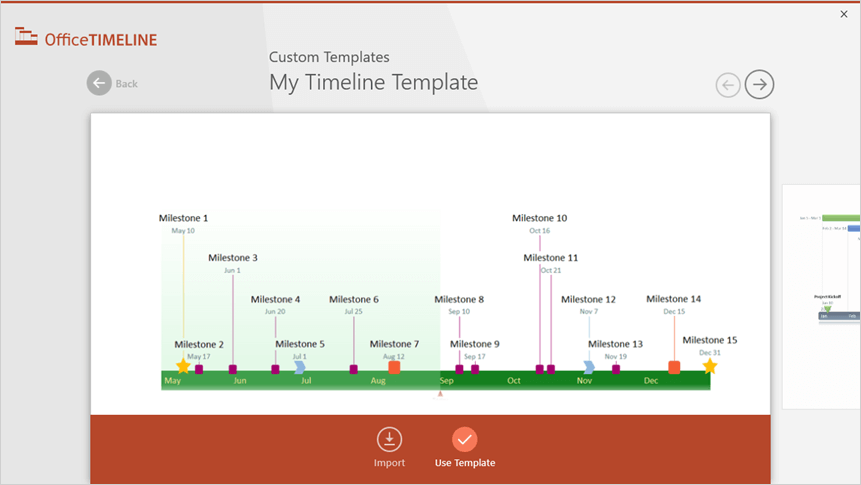
-
Now enter your milestones and set their dates, or copy & paste an existing schedule from Excel to save time. You can also make a few quick styling choices here, such as changing the color or shape of each item. Once ready, click the green Create button.
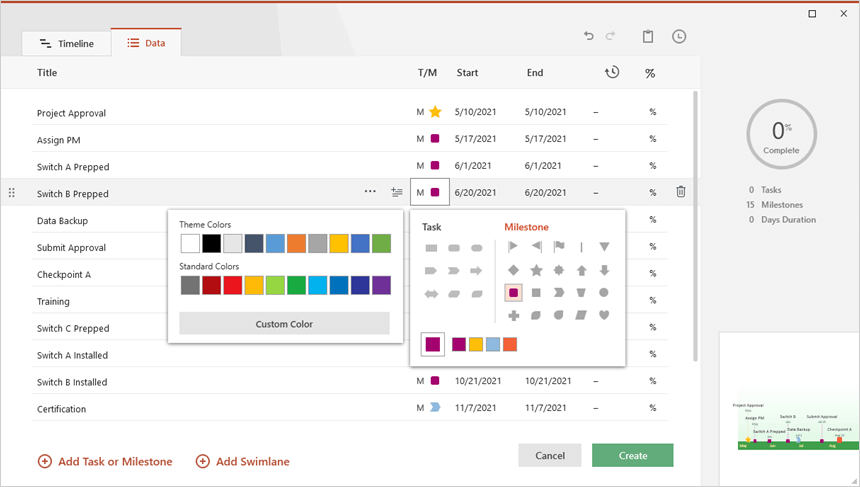
2. Instantly, you will have a new timeline slide in PowerPoint.
-
Depending on the style or template you've selected, you will get a PowerPoint timeline that looks similar to this:
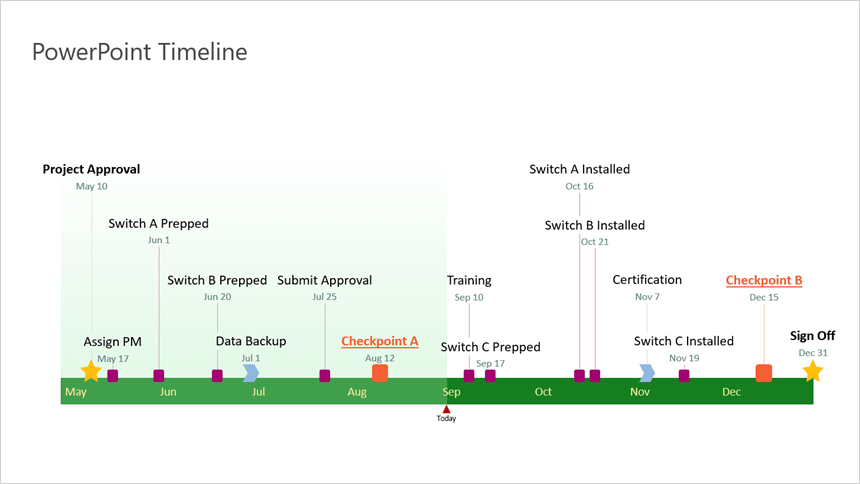
-
Once created, the timeline can be easily styled further or updated automatically using Office Timeline. For example, you can instantly change colors, shapes, and positions, switch the timescale from months to quarters, add tasks or swimlanes for a more complex visual, or adjust dates on the fly as your plans change.
Download auto-generated timeline slide
FAQ about making timelines in PowerPoint
How do you insert a timeline in PowerPoint?
There are multiple ways to insert a timeline in PowerPoint. One would be to access SmartArt tools -> Process -> Basic Timeline and edit the resulting graphic as described in the first tutorial on this page. Another solution would be to make a timeline in a design tool and then copy-paste it as an image onto your PowerPoint slide. The simplest and most convenient way, however, would be to use a dedicated PowerPoint timeline maker that would automate the process and allow you to easily update the visual directly from your slide, saving you time and effort.
Is there a timeline template in PowerPoint?
Other than the Basic Timeline graphic available through the SmartArt tools, there aren't any built-in timeline templates in PowerPoint. If you need inspiration to make a PowerPoint timeline or just want to save time customizing it, browse through our free template collection, which brings you dozens of stylish, easily-editable designs.
Can you make a timeline in Excel?
Yes, it is possible to create a timeline in Excel. It involves using the spreadsheet tool's Scatter Chart function and requires quite a bit of editing and tweaking to make the resulting visual look presentable. To see how it's done, check out our step-by-step Excel timeline tutorial.
How do I create a PowerPoint timeline from Excel data?
Making a PowerPoint timeline starting from an Excel sheet can be quite tricky if you want to do it manually. This is because, besides building the graphic itself, you'll need to copy-paste each individual data item from Excel and arrange it to fit the visual properly. That's why we recommend using Office Timeline instead, a timeline maker for PowerPoint that imports your schedule from Excel and automatically turns in into a beautiful timeline slide.
What is the best way to show a project timeline?
The best way to show a project timeline ultimately depends on who your audience is and on your specific purpose. For instance, for team check-ins, you can make a timeline in any of the productivity tools you and your colleagues are more comfortable with. For client communications or executive reviews, on the other hand, you might want to show your project timeline as a simple, visual PowerPoint slide, since high-level stakeholders are busy people and prefer a quick overview of the project.
See how to make a PowerPoint timeline in under 60 seconds:
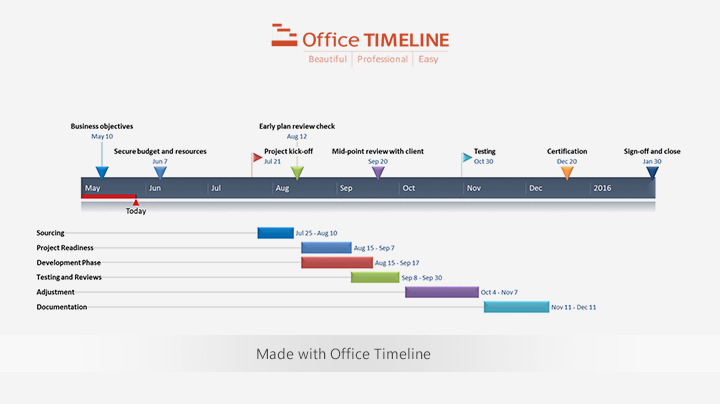
Play Video
Alternatively, you can create beautiful PowerPoint timelines that you can quickly share straight from your browser with Office Timeline's online timeline maker.
How To Apply Intense Effect Powerpoint 2016
Source: https://www.officetimeline.com/timeline/how-to-make/powerpoint
Posted by: blairacesturod.blogspot.com

0 Response to "How To Apply Intense Effect Powerpoint 2016"
Post a Comment